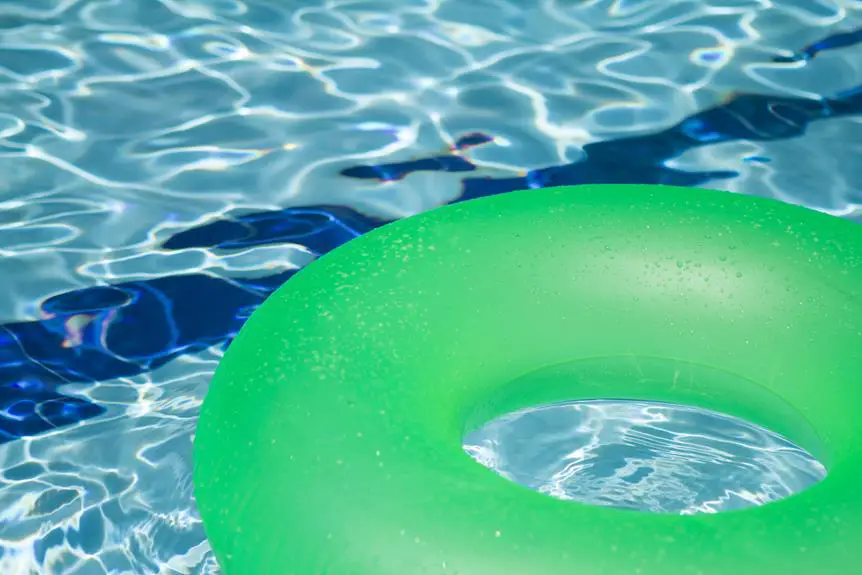Looking for the best fabric for your plastic pool cover? Did you know that a high-quality fabric can extend the lifespan of your pool cover by up to 20%?
When choosing a fabric for your plastic pool cover, durability, weather resistance, and cost-effectiveness are essential factors to consider. The right fabric should also provide UV protection and require minimal maintenance.
This involves carefully examining the material's strength, weight, and weave. Understanding these key aspects will help you make an informed decision about which fabric best suits your needs.
Key Takeaways
- Durability and resistance to UV rays are crucial for the longevity of the pool cover.
- Breathable fabric prevents moisture accumulation and mold growth.
- Dark-colored fabrics retain heat, while light-colored fabrics keep the pool water cooler.
- High-quality fabrics with UV protection safeguard the cover and contribute to its longevity.
Importance of Fabric Selection
When choosing a fabric for your plastic pool cover, you should look for durability and resistance to UV rays. The fabric's ability to withstand prolonged exposure to sunlight and harsh weather conditions is crucial for ensuring the longevity of the pool cover. Additionally, fabric breathability and moisture resistance are essential factors to consider. A breathable fabric allows air to circulate, preventing the accumulation of moisture and potential mold or mildew growth. Moisture resistance ensures that the fabric remains dry and maintains its structural integrity over time.
Fabric color options also play a significant role in the selection process. The color of the fabric not only contributes to the aesthetic appeal of the pool cover but also affects its functionality. Dark-colored fabrics tend to absorb more heat, which can be beneficial for retaining warmth in the pool water. On the other hand, light-colored fabrics reflect more sunlight, helping to keep the pool water cooler during hot days. Considering these factors, it's important to choose a fabric color that aligns with both your aesthetic preferences and practical needs.
Durability and Strength
To ensure the longevity and effectiveness of your plastic pool cover, it's crucial to select a fabric with exceptional durability and strength. The fabric's ability to withstand various environmental factors and maintain its structural integrity over time is essential for protecting your pool and extending the lifespan of the cover.
When considering the durability and strength of fabrics for plastic pool covers, several key factors should be taken into account:
- Material Composition: Opt for fabrics made from durable materials such as high-density polyethylene (HDPE) or vinyl, known for their strength and resistance to tearing and puncturing.
- Tensile Strength: Look for fabrics with high tensile strength, as this property indicates the material's ability to withstand stretching and pulling forces without breaking or deteriorating.
- UV Resistance: Choose fabrics with excellent UV resistance to ensure they can withstand prolonged exposure to sunlight without becoming brittle or discolored.
- Weather Resistance: Select fabrics that are resistant to harsh weather conditions, including rain, wind, and temperature fluctuations, to maintain their durability and strength over time.
Weather Resistance
When choosing a fabric for a plastic pool cover, it's important to consider its durability in various weather conditions.
You'll want a fabric that offers effective UV protection to ensure the pool cover can withstand prolonged exposure to sunlight.
Understanding how different fabrics hold up against weather elements will help you make an informed decision for your pool cover.
Fabric Durability in Weather
For plastic pool covers, the best fabrics exhibit excellent weather resistance, ensuring long-term durability and protection. When considering fabric durability in weather, it's important to look for specific characteristics that indicate the fabric's ability to withstand various weather conditions. Here are the key factors to consider:
- UV Resistance: Look for fabrics that offer high UV resistance to prevent degradation from prolonged exposure to sunlight.
- Water Resistance: Choose fabrics that are water-resistant to ensure they can withstand rain, snow, and humidity without deteriorating.
- Mold and Mildew Resistance: Opt for fabrics that have built-in resistance to mold and mildew, especially in humid environments.
- Temperature Resistance: Seek fabrics that can withstand extreme temperatures without becoming brittle or losing their strength.
These qualities contribute to the overall weather durability of the fabric, ensuring it can provide long-lasting protection for your plastic pool cover.
UV Protection Effectiveness
The UV protection effectiveness of the fabric is crucial for maintaining weather resistance and ensuring prolonged durability for your plastic pool cover.
High-quality fabrics with UV protection not only safeguard the cover from the damaging effects of the sun but also contribute to its longevity.
When considering UV protection, look for fabrics that are specifically designed to withstand prolonged sun exposure.
Regular fabric maintenance and cleaning are essential to preserve the UV protection qualities. Cleaning the cover with mild soap and water, and avoiding abrasive cleaners, will help maintain the fabric's UV resistance.
Additionally, periodic inspection for any signs of UV damage is recommended to ensure the cover continues to provide effective protection against the sun's rays.
Cost-Effectiveness
Consider the initial investment and long-term savings when evaluating the cost-effectiveness of different pool cover fabrics. Cost-effectiveness is crucial in choosing the best fabric for your plastic pool cover, as it not only impacts your upfront expenses but also the long-term maintenance and environmental impact.
Here are some key factors to consider:
- Fabric Lifespan: Evaluate the durability and expected lifespan of the fabric. A longer-lasting fabric may require a higher initial investment but can result in long-term cost savings by reducing the frequency of replacements.
- Environmental Impact: Consider the environmental impact of the fabric. Opting for materials that are eco-friendly and sustainable can contribute to cost-effectiveness in the long run by minimizing the need for frequent replacements and reducing your carbon footprint.
- Maintenance Costs: Factor in the maintenance requirements of the fabric. Some materials may require more frequent cleaning or maintenance, which can add to the overall cost of ownership.
- Energy Efficiency: Look for fabrics that offer energy-saving features, such as heat retention, which can lead to reduced heating costs and overall energy savings.
Maintenance and Cleaning
To maintain and clean your plastic pool cover effectively, regularly remove debris and dirt using a soft brush or gentle hose spray. It's important to clean the cover as part of its maintenance to ensure its longevity. Here are some cleaning methods and fabric care tips to help you keep your plastic pool cover in top condition:
| Cleaning Methods | Stain Removal | Fabric Care |
|---|---|---|
| Use a soft brush or gentle hose spray to remove debris and dirt. | For stubborn stains, mix mild detergent with water and gently scrub the affected area. | Avoid using harsh chemicals or abrasive cleaning tools to prevent damage to the fabric. |
| Regularly rinse the cover with clean water to prevent dirt buildup. | For oil or grease stains, apply a small amount of dish soap and gently blot the area with a soft cloth. | Allow the cover to air dry completely before storing it to prevent mold and mildew growth. |
| Periodically inspect the cover for any tears or damage, and patch them promptly to prevent further deterioration. | Avoid using bleach or ammonia-based cleaners, as they can weaken the fabric and cause discoloration. | Store the cover in a cool, dry place when not in use to prolong its lifespan. |
Following these cleaning methods and fabric care tips will help you maintain the quality and extend the life of your plastic pool cover.
UV Protection
When selecting fabrics for plastic pool covers, it's important to consider their UV resistance to ensure long-lasting protection against sun damage.
Fabrics with high UV resistance can effectively shield the pool from harmful UV rays, helping to maintain the cover's integrity and prolong its lifespan.
Look for materials that offer reliable UV protection, as this will contribute to the overall durability and performance of the pool cover.
Fabric UV Resistance
Choose a fabric with high UV resistance to ensure long-lasting protection for your plastic pool cover. UV resistance is crucial for maintaining the fabric's integrity and preventing it from degrading due to sun exposure.
When selecting a fabric for your pool cover, consider the following factors to ensure optimal UV protection:
- UV Resistance Rating: Look for fabrics with a high UV resistance rating, typically indicated by UPF (Ultraviolet Protection Factor) or UV resistance levels.
- Material Composition: Opt for synthetic materials like polyester or vinyl, as they offer excellent UV resistance compared to natural fibers like cotton.
- Colorfastness: Choose fabrics with good colorfastness, as darker colors and UV-stabilized pigments can enhance UV protection.
- UV Protective Coating: Consider fabrics with UV protective coatings or treatments for added resistance against sun damage.
Long-Lasting UV Protection
Prioritize long-lasting UV protection by selecting a fabric with high UV resistance for your plastic pool cover. This will ensure prolonged integrity and minimize maintenance efforts.
Fabric longevity is crucial for a plastic pool cover to withstand the harsh effects of UV radiation over time. Look for fabrics specifically designed with UV resistance properties to provide the best defense against degradation from prolonged sun exposure.
High-quality materials with UV inhibitors can significantly extend the lifespan of the pool cover, reducing the frequency of replacements and saving you money in the long run.
Additionally, UV-resistant fabrics help maintain the cover's appearance and functionality, ensuring it remains an effective barrier against debris and evaporation.
Investing in a fabric with excellent UV resistance is essential for maximizing the durability and effectiveness of your plastic pool cover.
Recommended Fabrics
You should consider looking into fabrics that hold up well against harsh weather conditions for your plastic pool cover. When selecting fabrics for your plastic pool cover, it's essential to choose materials that are durable and can withstand the elements to ensure longevity.
Here are some recommended fabric types to consider:
- Vinyl-Coated Polyester: This fabric is known for its exceptional durability and resistance to tearing and abrasion. It provides excellent protection against UV rays and harsh weather conditions, making it an ideal choice for a long-lasting pool cover.
- Polyethylene: Polyethylene fabrics are lightweight yet incredibly strong, making them suitable for withstanding outdoor elements. They offer excellent resistance to UV radiation, ensuring that your pool cover remains in good condition for an extended period.
- PVC: Polyvinyl chloride (PVC) fabrics are highly resistant to chemicals, tearing, and UV exposure. They're a popular choice for pool covers due to their durability and ability to maintain their integrity in various weather conditions.
- Polyester Mesh: Polyester mesh fabrics are designed to allow water to drain through while providing strong UV protection. These fabrics are breathable and resistant to mold and mildew, prolonging the life of the pool cover.
Consider these fabric options to ensure that your plastic pool cover remains durable and provides long-lasting protection for your pool.
Frequently Asked Questions
Can Plastic Pool Covers Made of Certain Fabrics Be Recycled at the End of Their Lifespan?
Yes, plastic pool covers made of certain fabrics can be recycled at the end of their lifespan. Recycling options depend on the fabric's durability, with some materials being more suitable for recycling than others.
Are There Any Fabric Options That Are Specifically Designed to Prevent Algae Growth on the Pool Cover?
To prevent algae growth on your pool cover, consider fabric options designed with anti-algae properties. These materials withstand temperature impact and some integrate automatic cleaning systems. Evaluate their environmental impact and recycling options for a sustainable choice.
How Do Different Fabrics Impact the Temperature of the Pool Water Underneath the Cover?
Different fabrics can impact the temperature of the pool water underneath the cover. Insulating fabrics help retain heat, while breathable fabrics allow for airflow, preventing condensation and maintaining a comfortable pool temperature.
Are There Any Fabric Options That Are Compatible With Automatic Pool Cover Systems?
For automatic cover compatibility, ensure the fabric's weight and flexibility align with the system's requirements. Look for durable options like vinyl or reinforced polyethylene, as these can withstand the repetitive stress of an automatic cover system.
What Are the Environmental Impacts of Using Certain Fabrics for Pool Covers?
Considering environmental impacts, fabric durability is crucial for pool covers. Certain fabrics, like vinyl, can release harmful chemicals and contribute to pollution. Opt for durable, eco-friendly options such as PVC-free materials to minimize environmental harm.
- How Does Ring Spun Cotton Affect Garment Fit and Shape Retention? - August 13, 2024
- What Are the Challenges in Producing Ring Spun Cotton? - August 13, 2024
- Is Ring Spun Cotton Suitable for Plus-Size Clothing? - August 13, 2024






